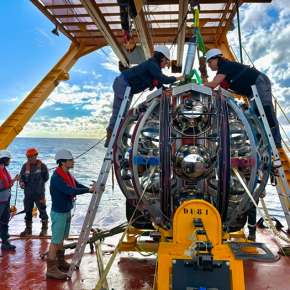Discovery of the Highest Energy Neutrino
Groundbreaking Event Detected in 2023
On February 13, 2023, scientists detected a remarkable high-energy neutrino, designated KM3-230213A, with an estimated energy of 220 PeV. This record-breaking event was captured by the ARCA detector of the KM3NeT neutrino telescope, located deep underwater. It marks the first evidence of neutrinos reaching such extreme energies in the Universe, shedding light on cosmic particle acceleration.
Characteristics of the Detected Neutrino
The event involved a single muon that traversed the detector, generating signals in over one-third of its active sensors. Its trajectory, combined with the immense energy, strongly indicates that the muon originated from a cosmic neutrino’s interaction near the telescope.
Insights Into High-Energy Events
High-energy astrophysical phenomena, such as supermassive black holes, supernovae, and gamma-ray bursts, are still not fully understood. These cataclysmic events act as cosmic accelerators that can produce neutrinos along with cosmic rays. During their journey, such cosmic rays may interact with other particles and photons, possibly generating exceptionally energetic “cosmogenic” neutrinos.
Significance of Neutrinos in Astrophysics
Neutrinos, nearly massless and devoid of electric charge, are elusive particles that provide essential insights into some of the Universe’s most energetic phenomena. According to Rosa Coniglione, Deputy-Spokesperson of KM3NeT, these particles are crucial for understanding fundamental processes and exploring the Universe’s depths.
KM3NeT: A Powerful Research Facility
The KM3NeT project, consisting of the ARCA and ORCA detectors, is an extensive deep-sea laboratory aimed at studying neutrinos. ARCA is situated at a depth of 3,450 meters, approximately 80 kilometers from Sicily, and is set up for high-energy neutrino observation. It utilizes seawater as an interaction medium, where photomultipliers detect Cherenkov light produced by neutrinos colliding with water molecules.
Design and Structure of KM3NeT
ARCA features detection units (DUs) anchored to the seabed, each housing 18 Digital Optical Modules with 31 photomultipliers. With plans for 230 DUs, the final configuration of ARCA will span over one cubic kilometer. Meanwhile, ORCA, positioned at 2,450 meters near Toulon, France, focuses on examining the fundamental properties of neutrinos, comprising 115 DUs optimized for these studies.
Future of Neutrino Astronomy
The groundbreaking neutrino detection fosters hope for future observations that could uncover more such high-energy events, enhancing our understanding of cosmic neutrinos. Ongoing expansions of the KM3NeT infrastructure aim to amplify its sensitivity and effectiveness in identifying cosmic neutrino sources.
Collaborative Effort and Funding
The KM3NeT initiative involves more than 360 scientists and engineers from various international institutions, enhancing its research capabilities. It is recognized in Europe as a critical infrastructure, supported by various research grants and funding programs including the European Regional Development Fund.
This unprecedented event represents a significant milestone in neutrino astronomy, opening avenues for future research in multi-messenger astronomy.

